A Power Flow Sensitivity-Based Approach for Distributed Voltage Regulation and Power Sharing in Droop-Controlled DC Distribution Networks
Abstract
1. Introduction
- Based on the power flow model of droop-controlled DCDNs, a comprehensive sensitivity model is established that explicitly captures the coupling among bus voltages, VSC loading rates, and VSC reference power adjustments.
- Leveraging the sensitivity model, a discrete-time linear time-invariant (LTI) state-space model is developed for DCDNs, using all VSC reference power as control variables, along with the weighted sum of the voltage deviation at the VSC buses and the loading rate deviation of adjacent VSCs as state variables. A distributed consensus controller is then designed to alleviate the communication burden.
- The feedback gain design problem is formulated as an unconstrained multi-objective optimization model, which simultaneously enhances dynamic response speed, suppresses overshoot and oscillation, and ensures stability. Owing to the low dimensionality of the gain matrix in typical control applications, the model can be efficiently solved by global optimization algorithms such as the genetic algorithm. As a result, the feedback gains can be designed in a systematic and principled manner, thereby overcoming the reliance on manual trial-and-error prevalent in existing strategies.
2. Power Flow Sensitivity Analysis of DCDNs
2.1. Sensitivity of Voltages with Respect to VSC Reference Power
2.2. Sensitivity of VSC Loading Rates with Respect to VSC Reference Power
3. Power Flow Sensitivity-Based Distributed Cooperative Control
3.1. Discrete-Time LTI State Space Model of a DCDN
3.2. Distributed Cooperative Controller
3.3. Optimal Parameter Design and Closed-Loop Stability Analysis
- (1)
- The modulus of the eigenvalues dictates the convergence speed;
- (2)
- The radial angle influences the amplitude of oscillation and overshoot;
- (3)
- The spectral radius must be strictly less than unity to guarantee system stability.
4. Simulation Results
4.1. Spectral Radius Analysis of the Closed-Loop System
4.2. Performance Under Conventional Manual Gain Tuning
- (1)
- At t = 1 s, the outputs of all PV units drop to half of the original values;
- (2)
- At t = 11 s, the outputs of all PV units restore to the original values.
- (1)
- Scheme 1: the feedback gains are set uniformly as k = [0.1, 0.1, 0.1, 0.1];
- (2)
- Scheme 2: the feedback gains are set uniformly as k = [0.2, 0.2, 0.2, 0.2];
- (3)
- Scheme 3: the feedback gains are set as k = [0.223, 0.297, 0.283, 0.375], which is obtained by minimizing the spectral radius using the genetic algorithm;
- (4)
- Scheme 4: the feedback gains are set uniformly as k = [0.398, 0.398, 0.398, 0.398], which corresponds to the stability boundary point in Figure 5.
- (1)
- Scheme 1 (k = [0.1, 0.1, 0.1, 0.1]) restores the voltage in 10 control cycles;
- (2)
- Scheme 2 (k = [0.2, 0.2, 0.2, 0.2]) exhibits a faster response, stabilizing the voltage within 4 control cycles;
- (3)
- Scheme 3 (k = [0.223, 0.297, 0.283, 0.375]) requires 8 control cycles to restore voltage, but introduces overshoot. Although this gain set is optimized via genetic algorithm for minimal spectral radius, it prioritizes stability and leads to overshoot due to aggressive power reference adjustments;
- (4)
- Scheme 4 (k = [0.398, 0.398, 0.398, 0.398]) results in more severe overshoot and brings the voltage back to 1.0 p.u. through damped oscillations.

4.3. Performance Validation and Comparison of the Proposed Optimization-Based Method
4.4. Performance Validation and Comparison Under Radial Topology
5. Conclusions
- The proposed distributed control method achieves rapid voltage recovery and converter load sharing under a sparse communication network.
- Thanks to the proposed power flow sensitivity-based state-space model, feedback gain design can be conducted in a systematic and principled manner such that the design complexity and parameter adjustment difficulties are greatly reduced while strictly ensuring closed-loop stability.
Author Contributions
Funding
Data Availability Statement
Conflicts of Interest
Nomenclature
| Input matrix of the discrete-time LTI state model. | |
| Nonlinear power equation corresponding to bus i. | |
| The (i,j)th element of the network nodal conductance matrix. | |
| Closed-loop system matrix, . | |
| Jacobian matrix of power injections with respect to bus voltages at the steady-state operating point, whose (i,j)th element is . | |
| Total cost function for optimization of feedback control gains. | |
| Cost to penalize the slow convergence of the system’s response. | |
| Cost to penalize excessive overshoot and oscillatory behavior of the system’s dynamic response. | |
| Cost to enforces the stability margin of the closed-loop system. | |
| Diagonal feedback control gain matrix. | |
| Feedback control gain of the VSC at bus i. | |
| Loading rate of the VSC at bus i. | |
| Loading rate vector of all VSCs. | |
| Sensitivity matrix between the VSC loading rate vector and the VSC reference power vector. | |
| m | Number of all VSCs in the DCDN. |
| n | Number of all buses in the DCDN. |
| Set of all neighboring buses of bus i (including bus i itself). | |
| Cardinality of . | |
| Vector of all power injection increments. | |
| Vector of reference power increments of all VSC buses. | |
| Vector of power increments of all non-VSC buses. | |
| Specified power injection of the non-VSC bus i. | |
| Power reference of the VSC at bus i | |
| Capacity of the VSC at bus i. | |
| Spectral radius of the closed-loop system matrix . | |
| Droop coefficient of the VSC at bus i. | |
| Sensitivity matrix between the VSC bus voltage vector and the VSC reference power vector. | |
| Control variable vector during the kth control. | |
| Vector of all bus voltages. | |
| Vector of all bus voltage increments. | |
| Vector of bus voltage increments of all VSC buses. | |
| Vector of bus voltage increments of all non-VSC buses. | |
| Voltage of the bus i. | |
| Voltage reference of the VSC at bus i. | |
| Voltage reference value (fixed at 1.0 p.u.). | |
| Weighting coefficients of costs for optimization of control gains. | |
| local state variable of the VSC at bus i. | |
| State variable vector during the kth control. | |
| Output variable vector during the kth control. | |
| The i-th eigenvalue of the closed-loop system matrix . | |
| Angle of . | |
| Maximum allowable eigenvalue angle for overshoot suppression. | |
| Target eigenvalue magnitude (modulus) for convergence speed regulation. | |
| Stability margin quantifying the distance from the stability boundary. |
References
- Fu, Q.; Du, W.; Wang, H.; Ma, X.; Xiao, X. DC voltage oscillation stability analysis of DC-voltage-droop-controlled multiterminal DC distribution system using reduced-order modal calculation. IEEE Trans. Smart Grid 2022, 13, 4327–4339. [Google Scholar] [CrossRef]
- Deng, W.; Pei, W.; Wu, Q.; Zhuang, Y. Analysis of interactive behavior and stability of low-voltage multiterminal DC system under droop control modes. IEEE Trans. Power Electron. 2022, 69, 4327–4339. [Google Scholar] [CrossRef]
- Liu, C.; Li, B.; Zhang, Y.; Jiang, Q.; Liu, T. The LCC type DC grids forming method and fault ride-through strategy based on fault current limiters. Int. J. Electr. Power Energy Syst. 2025, 170, 110843. [Google Scholar] [CrossRef]
- Gao, F.; Kang, R.; Cao, J.; Yang, T. Primary and secondary control in DC microgrids: A review. J. Mod. Power Syst. Clean Energy 2019, 7, 227–242. [Google Scholar] [CrossRef]
- Xie, X.; Quan, X.; Wu, Z.; Cao, X.; Hu, W.; Dou, X.; Hu, Q. A novel peer-to-peer control strategy for multiterminal DC distribution systems. IEEE Trans. Smart Grid 2023, 14, 785–797. [Google Scholar] [CrossRef]
- Wang, Y.; He, J.; Zhao, Y.; Liu, G.; Sun, J.; Li, H.; Wang, C. Equal loading rate based master–slave voltage control for VSC based DC distribution systems. IEEE Trans. Power Deliv. 2020, 35, 2252–2259. [Google Scholar] [CrossRef]
- Xie, X.; Quan, X.; Wu, Z.; Cao, X.; Dou, X.; Hu, Q. Adaptive master-slave control strategy for medium voltage DC distribution systems based on a novel nonlinear droop controller. IEEE Trans. Smart Grid 2021, 12, 4765–4777. [Google Scholar] [CrossRef]
- Liu, Q.; Chen, H.; Liang, D.; Ji, X.; Zhang, L. Collaborative optimization of reference powers and droop coefficients in DC distribution networks considering flexibility enhancement. Sustain. Energy Grids Netw. 2024, 39, 101416. [Google Scholar] [CrossRef]
- Liu, Q.; Wang, Y.; Wang, S.; Liang, D.; Zhao, Q.; Zhao, X. Voltage regulation strategy for DC distribution networks based on coordination of centralized control and adaptive droop control. IEEE Trans. Power Deliv. 2022, 37, 3730–3739. [Google Scholar] [CrossRef]
- Sun, P.; Pinthurat, W.; Li, G.; Khalid, M.; Town, G.E.; Konstantinou, G. Adaptive droop control in VSC-based MT-MVDC distribution systems considering ESS participationn. IEEE Trans. Energy Convers. 2025, 40, 761–772. [Google Scholar] [CrossRef]
- Moradi, M.; Heydari, M.; Zarei, S.F. An overview on consensus-based distributed secondary control schemes in DC microgrids. Elect. Power Syst. Res. 2023, 225, 109870. [Google Scholar] [CrossRef]
- Nasirian, V.; Moayedi, S.; Davoudi, A.; Lewis, F.L. Distributed cooperative control of DC microgrids. IEEE Trans. Power Electron. 2015, 30, 2288–2303. [Google Scholar] [CrossRef]
- Li, Y.; Zhang, Z.; Dragičević, T.; Rodriguez, J. A unified distributed cooperative control of DC microgrids using consensus protocol. IEEE Trans. Smart Grid 2021, 12, 1880–1892. [Google Scholar] [CrossRef]
- Sahoo, S.; Mishra, S. A distributed finite-time secondary average voltage regulation and current sharing controller for DC microgrids. IEEE Trans. Smart Grid 2019, 10, 282–292. [Google Scholar] [CrossRef]
- Li, X.; Hu, C.; Luo, S.; Lu, H.; Piao, Z.; Jing, L. Distributed hybrid-triggered observer-based secondary control of multi-bus DC microgrids over directed networks. IEEE Trans. Circuits Syst. I 2025, 72, 2467–2480. [Google Scholar] [CrossRef]
- Du, Y.; Lu, X.; Tang, W. Accurate distributed secondary control for DC microgrids considering communication delays: A surplus consensus-based approach. IEEE Trans. Smart Grid 2022, 13, 1709–1719. [Google Scholar] [CrossRef]
- Yuan, Q.; Wang, Y.; Liu, X.; Lei, Y. Distributed fixed-time secondary control for DC microgrid via dynamic average consensus. IEEE Trans. Sustain. Energy 2021, 12, 2008–2018. [Google Scholar] [CrossRef]
- Shafiee, P.; Khayat, Y.; Batmani, Y.; Shafiee, Q.; Guerrero, G.M. On the design of event-triggered consensus-based secondary control of DC microgrids. IEEE Trans. Power Syst. 2022, 37, 3834–3846. [Google Scholar] [CrossRef]
- Wang, Z.; Wu, W.; Zhang, B. A fully distributed power dispatch method for fast frequency recovery and minimal generation cost in autonomous microgrids. IEEE Trans. Smart Grid 2016, 7, 19–31. [Google Scholar] [CrossRef]
- Xu, Y.; Guo, Q.; Sun, H.; Fei, Z. Distributed discrete robust secondary cooperative control for islanded microgrids. IEEE Trans. Smart Grid 2019, 10, 3620–3629. [Google Scholar] [CrossRef]
- Yang, G.; Ding, L.; Ye, M.; Xiao, S.; Yue, D. Distributed accurate current sharing for multi-bus DC microgrids with minimizing voltage regulation deviations: A game-theoretic approach. IEEE Trans. Smart Grid 2025, 16, 2725–2737. [Google Scholar] [CrossRef]
- Lee, G.Y.; Ko, B.S.; Cho, J.; Kim, R.Y. A distributed control method based on a voltage sensitivity matrix in DC microgrids with low-speed communication. IEEE Trans. Smart Grid 2019, 10, 4–15. [Google Scholar] [CrossRef]
- Liu, Q.; Zhang, L.; Zhang, H.; Wang, S.; Ji, X. Distributed secondary optimal control with fast voltage recovery and minimum generation cost for islanded DC microgrids. IEEE Trans. Smart Grid 2025, 16, 4–15. [Google Scholar] [CrossRef]
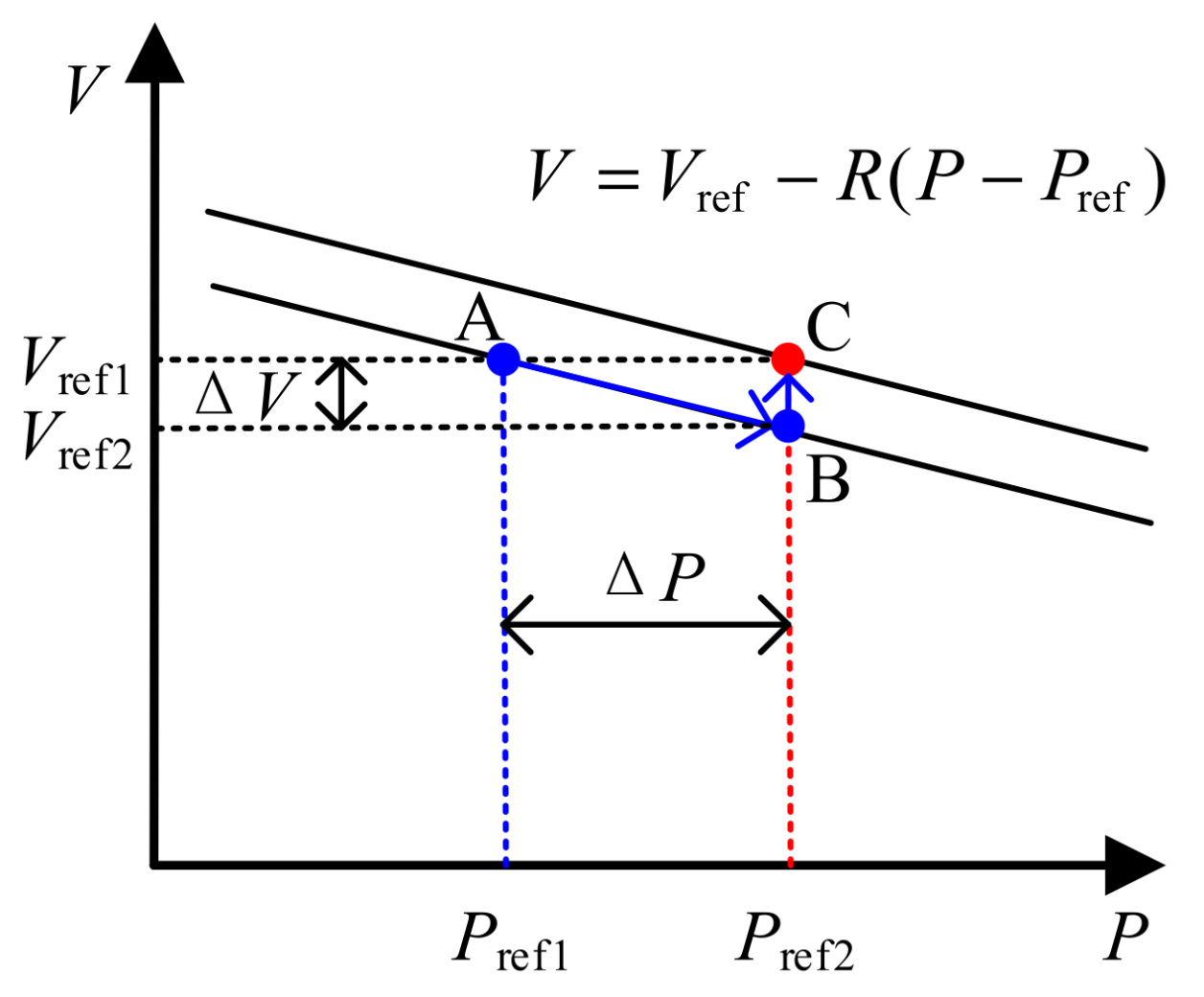


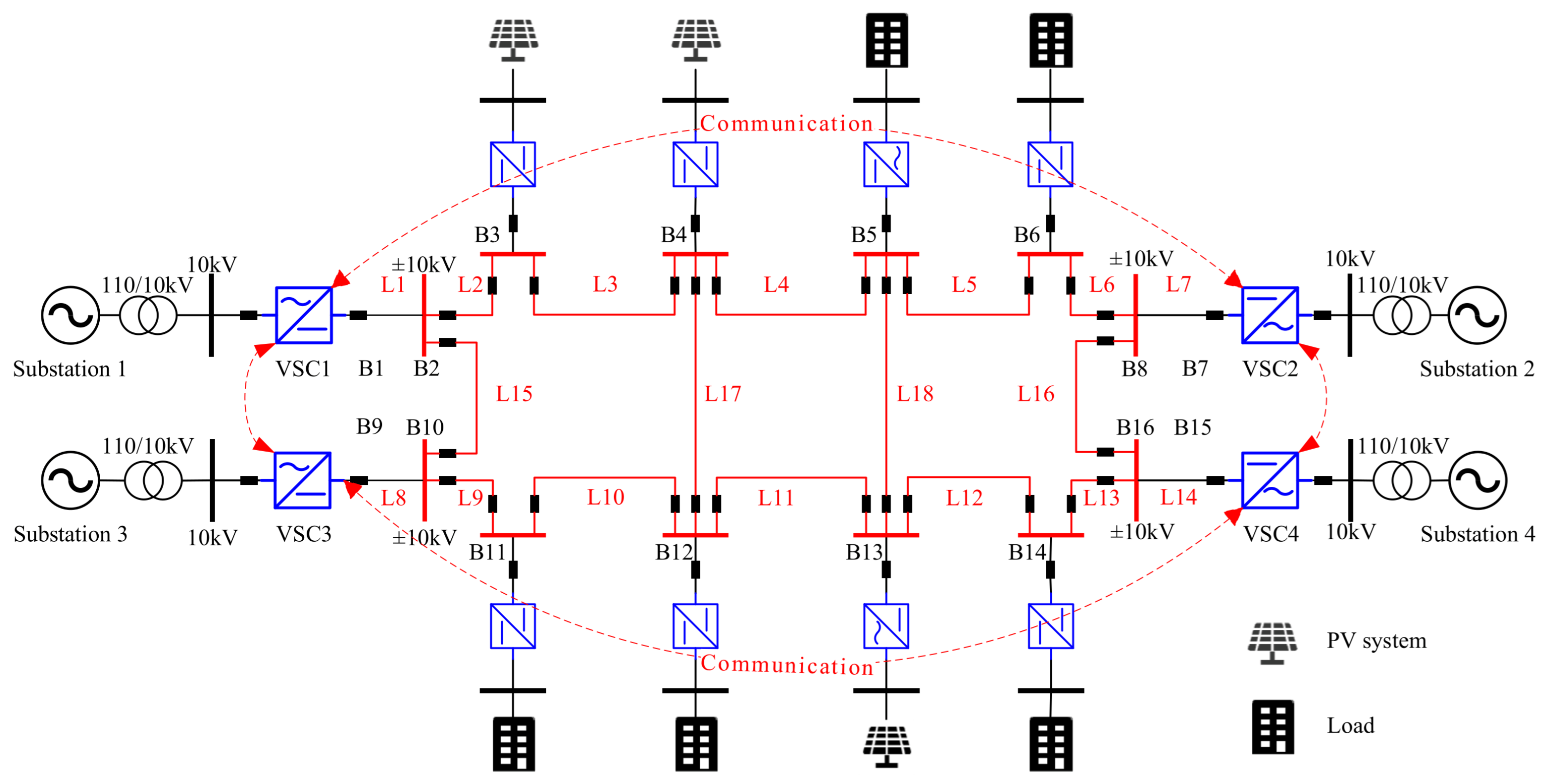
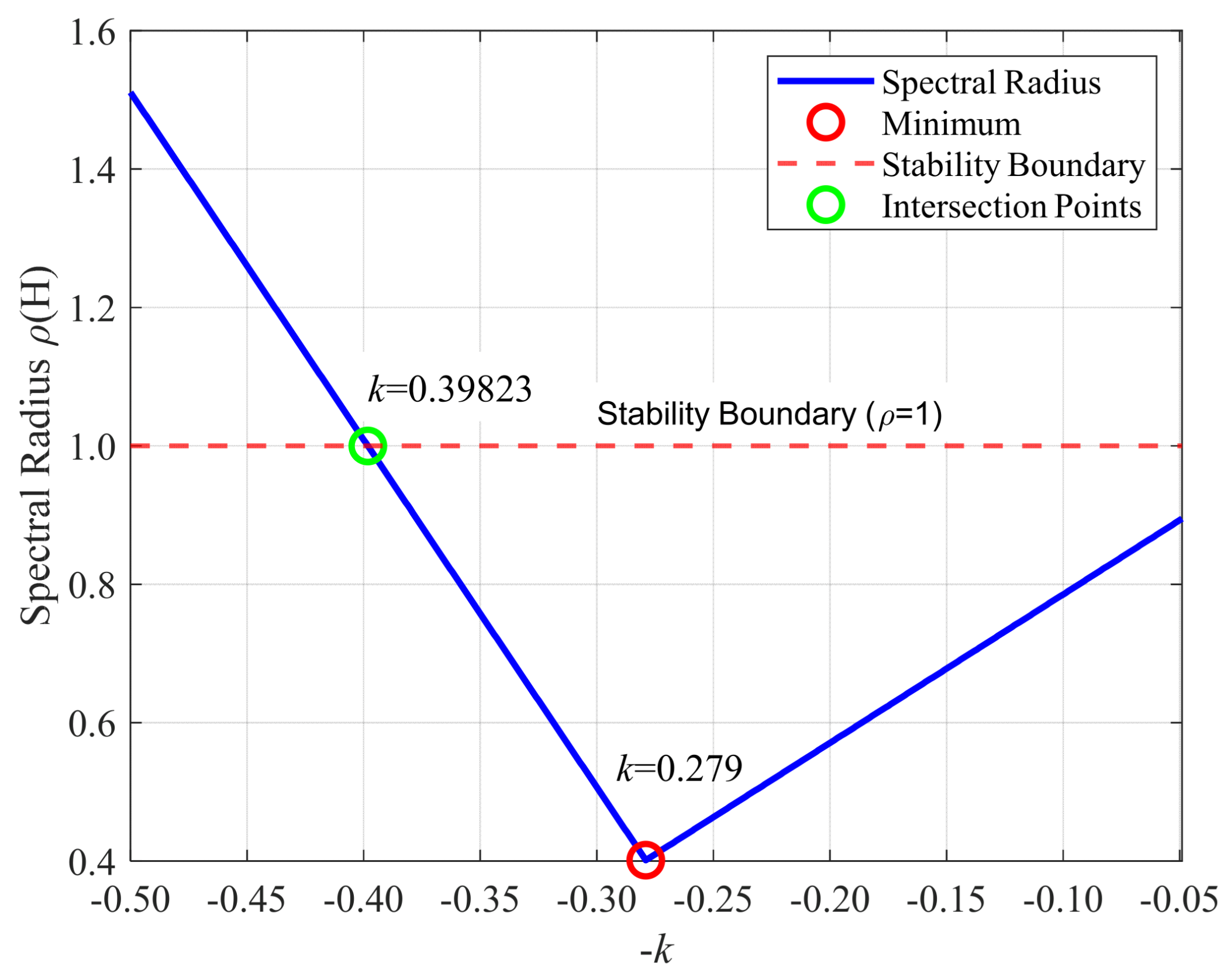
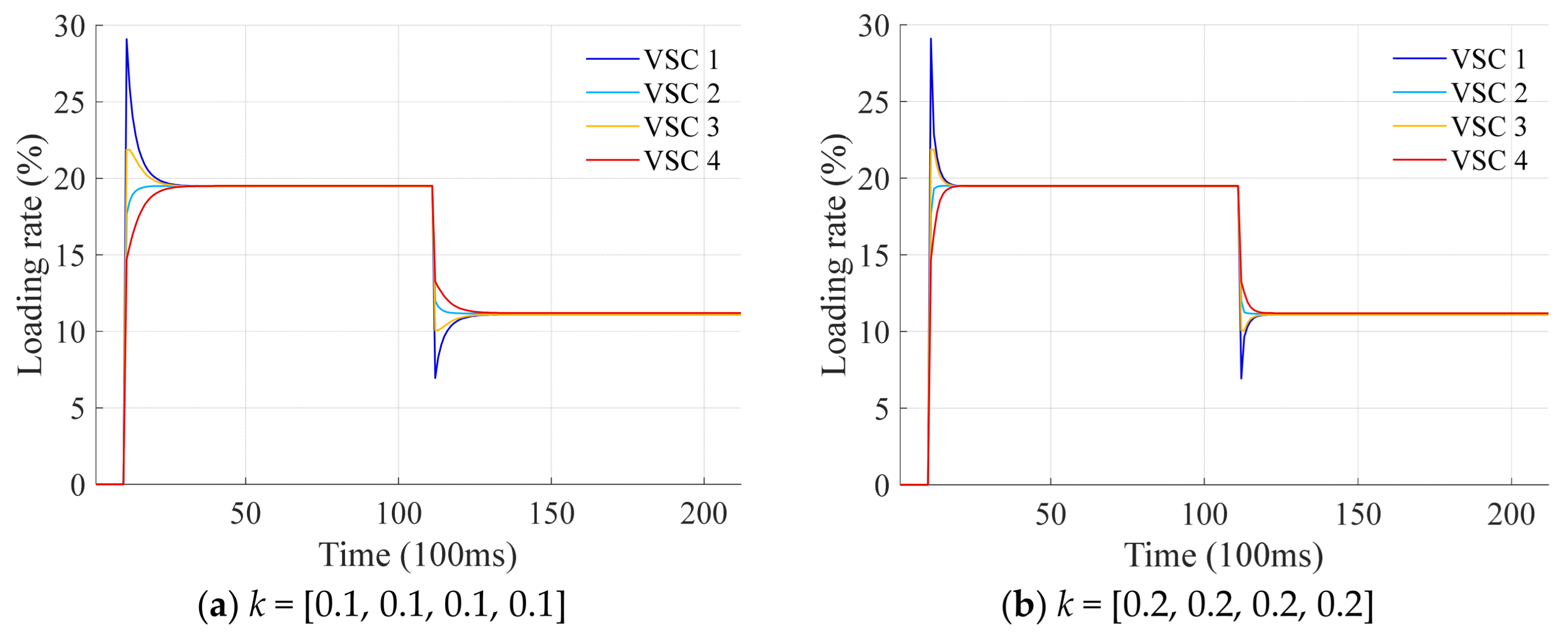

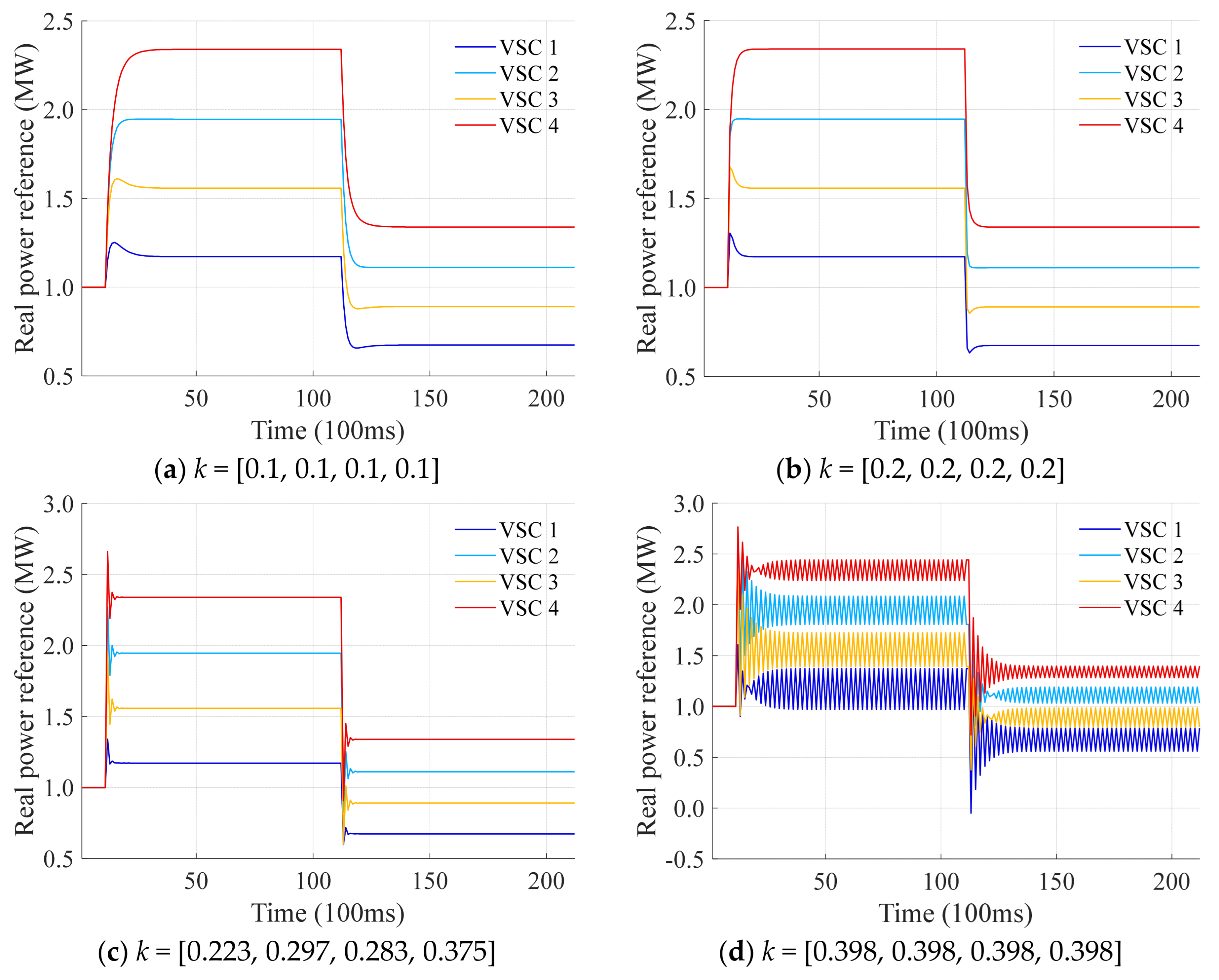
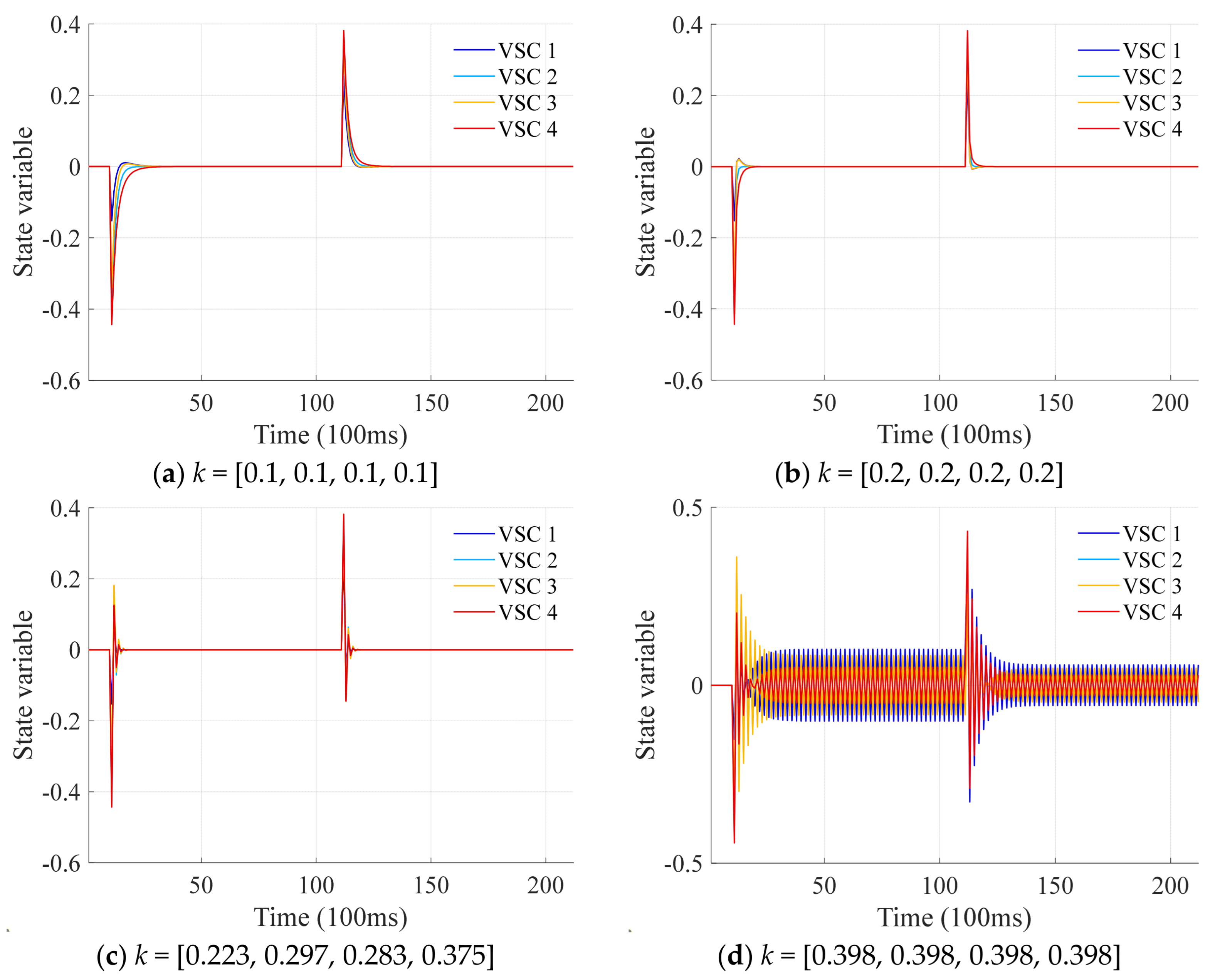
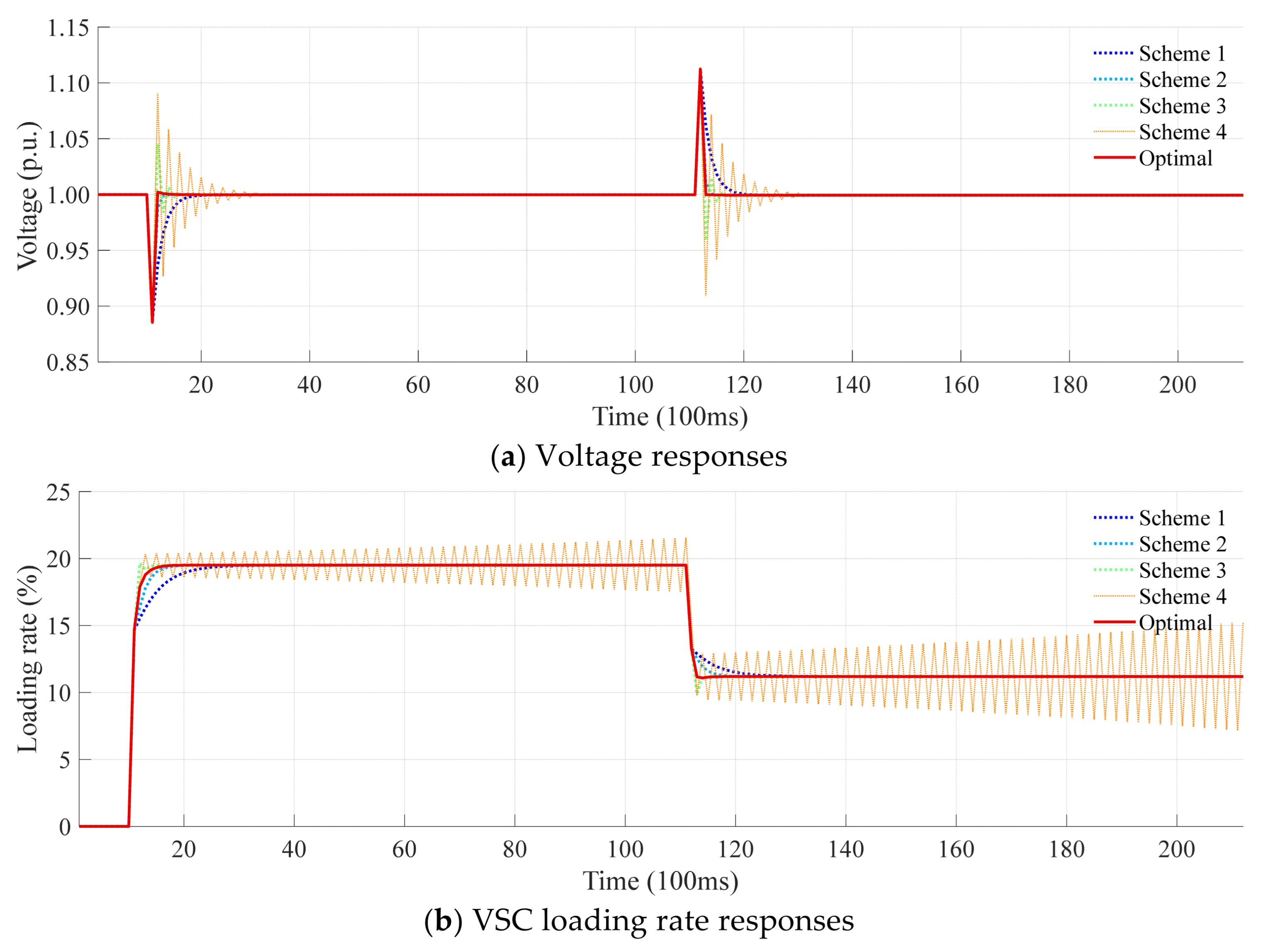
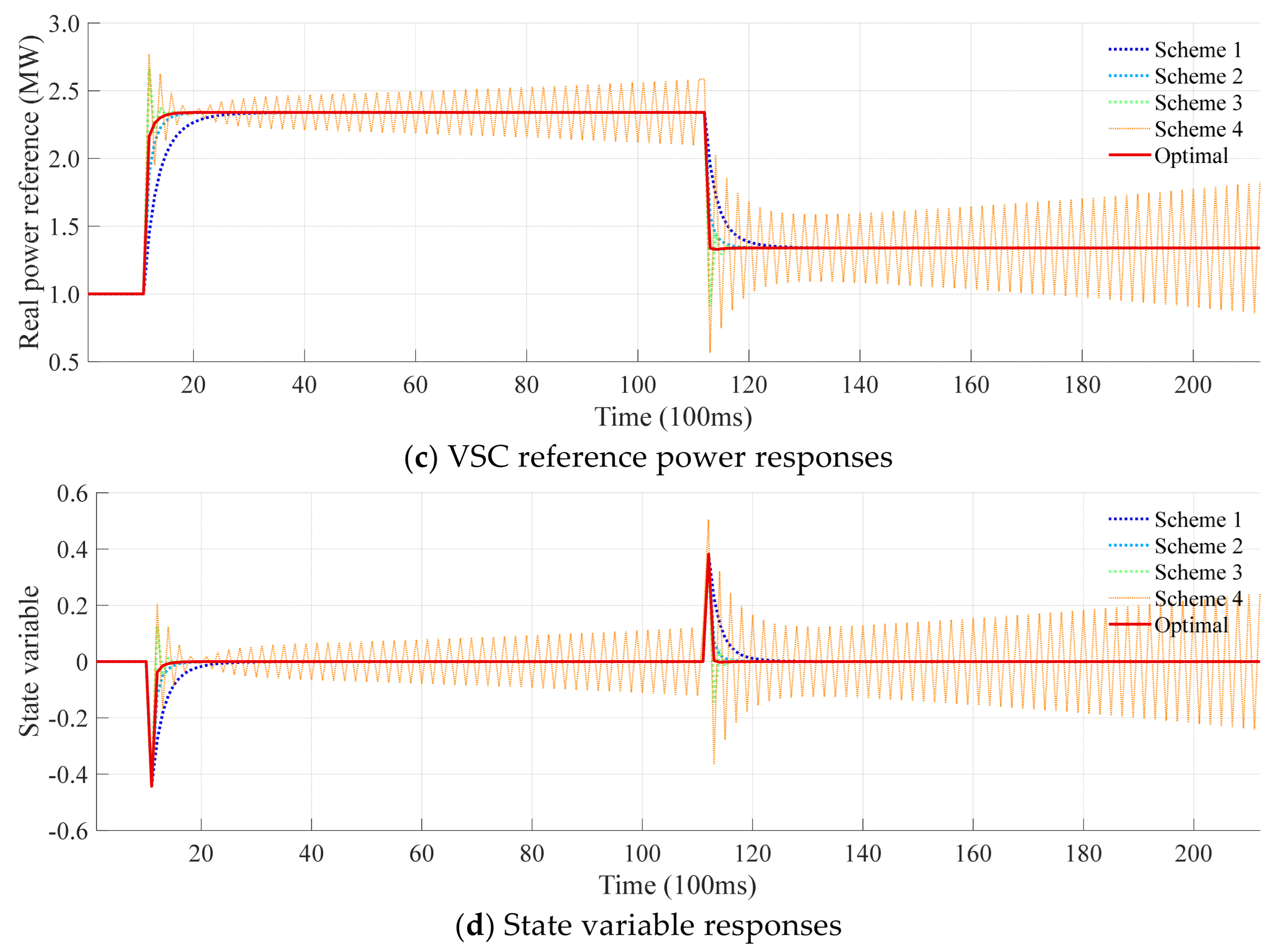
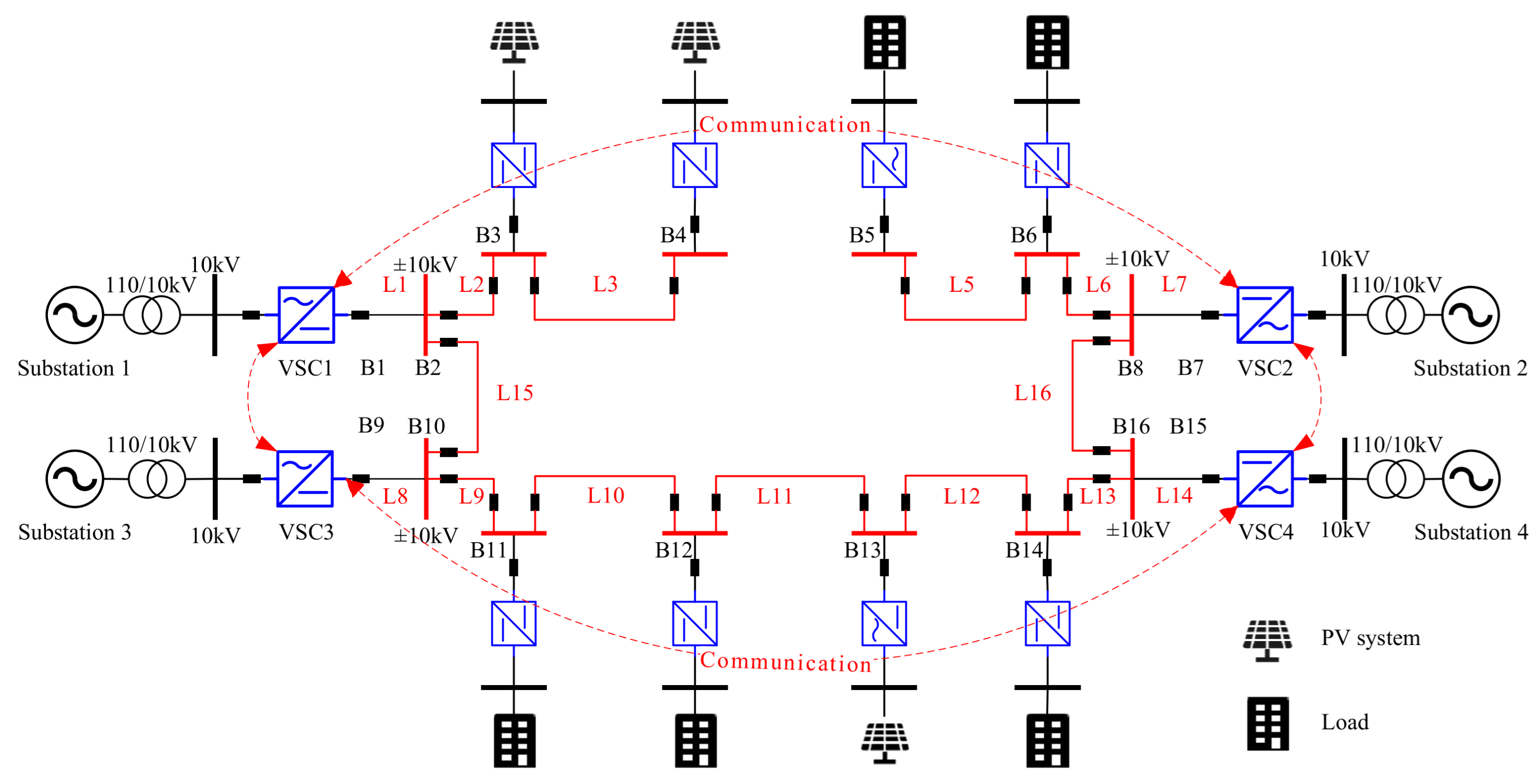

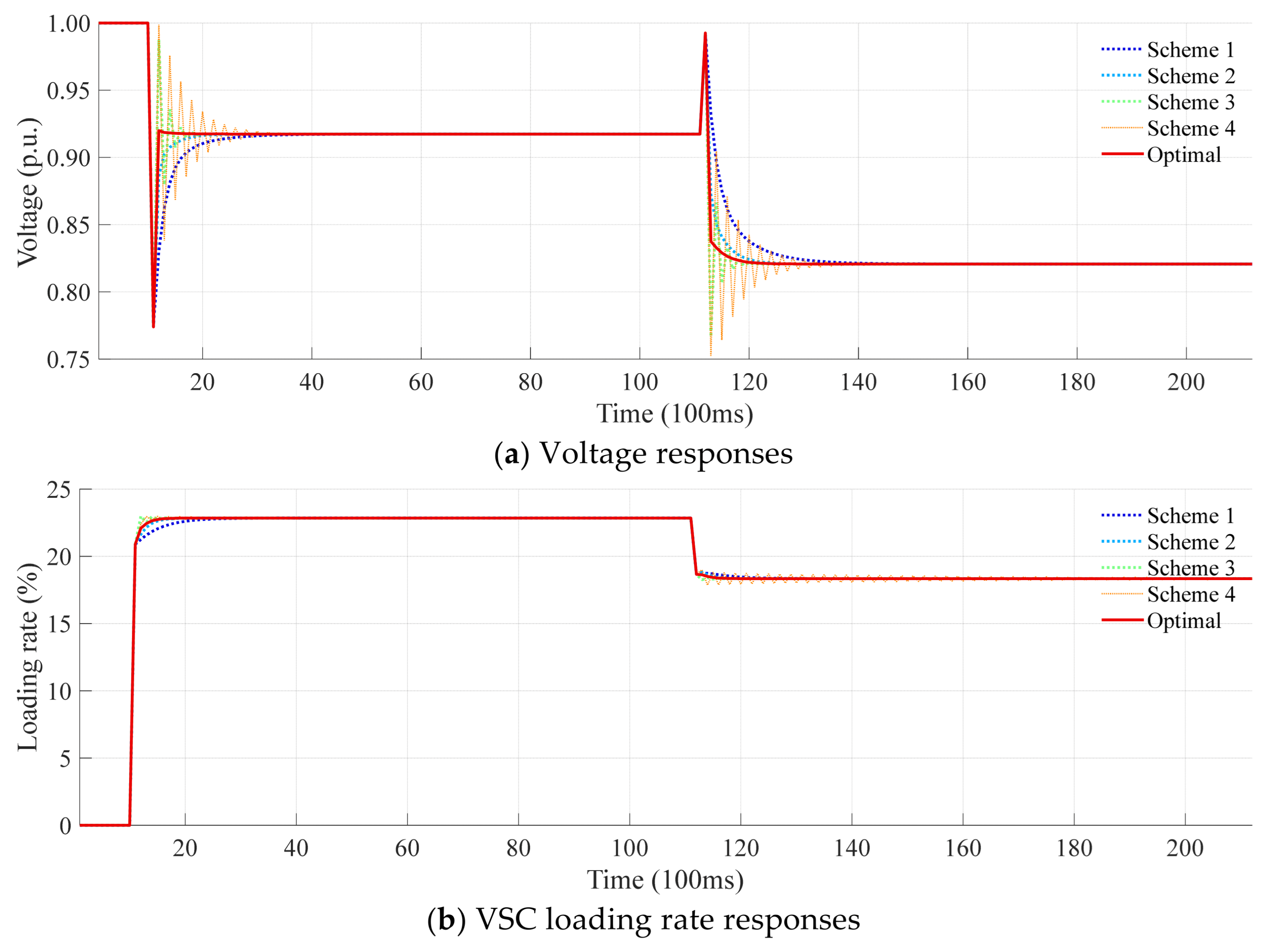
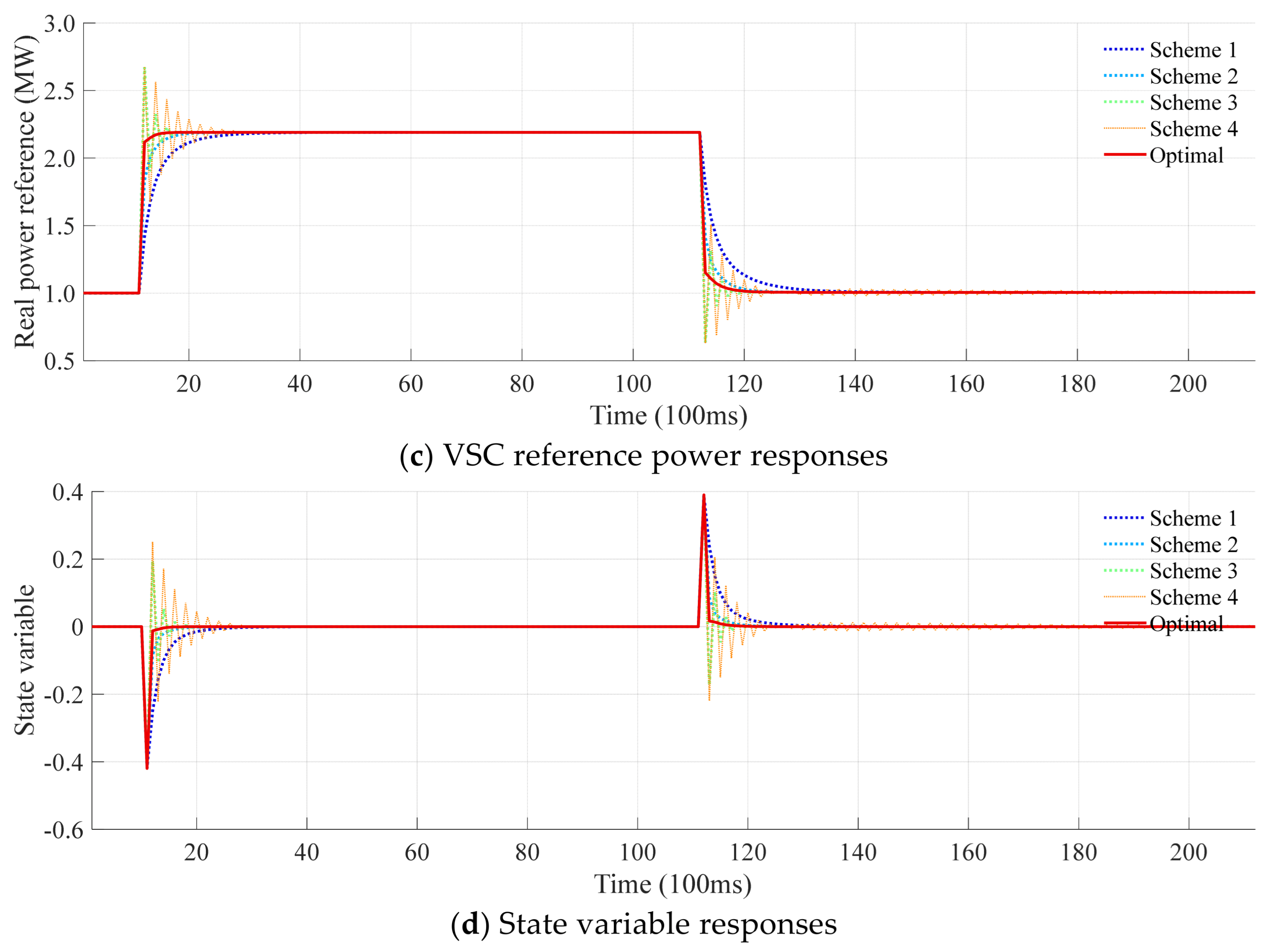
| References | System Model | Direct Feedback Control? | Stability/Convergence Analysis | Needs Gain Tuning? |
|---|---|---|---|---|
| [12] | Small signal model | Average voltage observer | None | Y |
| [13] | Large signal model | Average voltage observer | Input-to-state stability analysis | Y |
| [14] | Model-free | Average voltage observer | Lyapunov stability analysis | Y |
| [15] | Model-free | Average voltage observer | Lyapunov stability analysis | Y |
| [16] | Small signal model | Average voltage observer | Delay-dependent stability analysis | Y |
| [17] | Model-free | Average voltage observer | Lyapunov stability analysis | N |
| [18] | Small signal model | Direct feedback control | Lyapunov stability analysis | Y |
| [19] | Power flow model | Direct feedback control | Convergence analysis | Y |
| [20] | Power flow model | Disturbance estimator | Convergence analysis | Y |
| [21] | Power flow model | Global state observer | Convergence analysis | Y |
| [22] | Power flow model | Direct feedback control | Pole-zero analysis | N |
| [23] | Power flow model | Global state observer | Schur stability analysis | N |
| This paper | Power flow model | Direct feedback control | Schur stability analysis | N |
| Bus | B3 | B4 | B5 | B6 | B11 | B12 | B13 | B14 |
|---|---|---|---|---|---|---|---|---|
| Load (MW) | −2 | −2 | 2 | 2 | 2 | 2 | −2 | 2 |
| Line | L1 | L2 | L3 | L4 | L5 | L6 | L7 | L8 | L9 |
| Length (km) | 0.2 | 0.9 | 0.5 | 0.9 | 0.5 | 0.5 | 0.2 | 0.2 | 0.9 |
| Line | L10 | L11 | L12 | L13 | L14 | L15 | L16 | L17 | L18 |
| Length (km) | 0.5 | 0.9 | 0.5 | 0.5 | 0.2 | 0.9 | 0.9 | 0.9 | 0.9 |
| VSC | VSC 1 | VSC 2 | VSC 3 | VSC 4 |
|---|---|---|---|---|
| Capacity (MW) | 6 | 10 | 8 | 12 |
| Droop coefficient (kV/MW) | 1.5 | 1.5 | 1.5 | 1.5 |
Disclaimer/Publisher’s Note: The statements, opinions and data contained in all publications are solely those of the individual author(s) and contributor(s) and not of MDPI and/or the editor(s). MDPI and/or the editor(s) disclaim responsibility for any injury to people or property resulting from any ideas, methods, instructions or products referred to in the content. |
© 2025 by the authors. Licensee MDPI, Basel, Switzerland. This article is an open access article distributed under the terms and conditions of the Creative Commons Attribution (CC BY) license (https://creativecommons.org/licenses/by/4.0/).
Share and Cite
Jiang, N.; Gao, H.; Zhang, X.; Zhang, Z.; Peng, Y.; Liang, D. A Power Flow Sensitivity-Based Approach for Distributed Voltage Regulation and Power Sharing in Droop-Controlled DC Distribution Networks. Energies 2025, 18, 5382. https://doi.org/10.3390/en18205382
Jiang N, Gao H, Zhang X, Zhang Z, Peng Y, Liang D. A Power Flow Sensitivity-Based Approach for Distributed Voltage Regulation and Power Sharing in Droop-Controlled DC Distribution Networks. Energies. 2025; 18(20):5382. https://doi.org/10.3390/en18205382
Chicago/Turabian StyleJiang, Nan, He Gao, Xingyu Zhang, Zhe Zhang, Yufei Peng, and Dong Liang. 2025. "A Power Flow Sensitivity-Based Approach for Distributed Voltage Regulation and Power Sharing in Droop-Controlled DC Distribution Networks" Energies 18, no. 20: 5382. https://doi.org/10.3390/en18205382
APA StyleJiang, N., Gao, H., Zhang, X., Zhang, Z., Peng, Y., & Liang, D. (2025). A Power Flow Sensitivity-Based Approach for Distributed Voltage Regulation and Power Sharing in Droop-Controlled DC Distribution Networks. Energies, 18(20), 5382. https://doi.org/10.3390/en18205382





